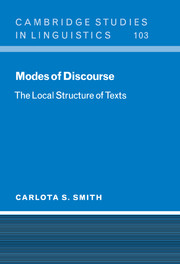Book contents
- Frontmatter
- Contents
- Preface
- Introduction
- PART I DISCOURSE STRUCTURE
- PART II LINGUISTIC ANALYSIS OF THE DISCOURSE MODES
- 4 Aspectual information: the entities introduced in discourse
- 5 Temporal and spatial progression
- 6 Referring expressions in discourse
- PART III SURFACE PRESENTATIONAL FACTORS
- PART IV DISCOURSE MODES AND THEIR CONTEXT
- Appendix A The Texts
- Appendix B Glossary
- References
- General index
- Index of names
4 - Aspectual information: the entities introduced in discourse
Published online by Cambridge University Press: 18 June 2010
- Frontmatter
- Contents
- Preface
- Introduction
- PART I DISCOURSE STRUCTURE
- PART II LINGUISTIC ANALYSIS OF THE DISCOURSE MODES
- 4 Aspectual information: the entities introduced in discourse
- 5 Temporal and spatial progression
- 6 Referring expressions in discourse
- PART III SURFACE PRESENTATIONAL FACTORS
- PART IV DISCOURSE MODES AND THEIR CONTEXT
- Appendix A The Texts
- Appendix B Glossary
- References
- General index
- Index of names
Summary
The Discourse Modes introduce situation entities into the universe of discourse, and have different principles of text progression. The information is conveyed by forms of aspect and temporal location. The two are complementary. Temporal location locates a situation in time, while aspect specifies the internal temporal structure of the situation. This chapter is devoted to aspect; temporal location is discussed in Chapter 5.
The understanding of aspect is the key to the analysis of Discourse Modes, because the situation entities are aspectual in nature. The Discourse Modes characteristically introduce different types of situation entities. Passages of the Narrative and Report modes primarily involve Events and States. The Description mode primarily concerns States and ongoing Events. The Information mode primarily has General Statives; the Argument mode primarily has Abstract Entities, Facts and Propositions, and General Statives. After a brief introduction to aspectual systems, this chapter discusses the concepts of situation entities and their linguistic correlates, and how aspectual information is encoded in Discourse Representation Theory.
Section 4.1 introduces the two components of aspectual systems and discusses Event and State situation types, including shifts of one type to another; 4.2 discusses General Statives; 4.3 discusses Abstract Entities; 4.4 discusses the linguistic correlates for the three major classes of situation type; 4.5 covers aspectual information in Discourse Representation Structures.
Aspectual categories
The two components of aspectual systems
Aspect is a sub-system of language that conveys information about the internal temporal structure of situations.
- Type
- Chapter
- Information
- Modes of DiscourseThe Local Structure of Texts, pp. 67 - 91Publisher: Cambridge University PressPrint publication year: 2003



